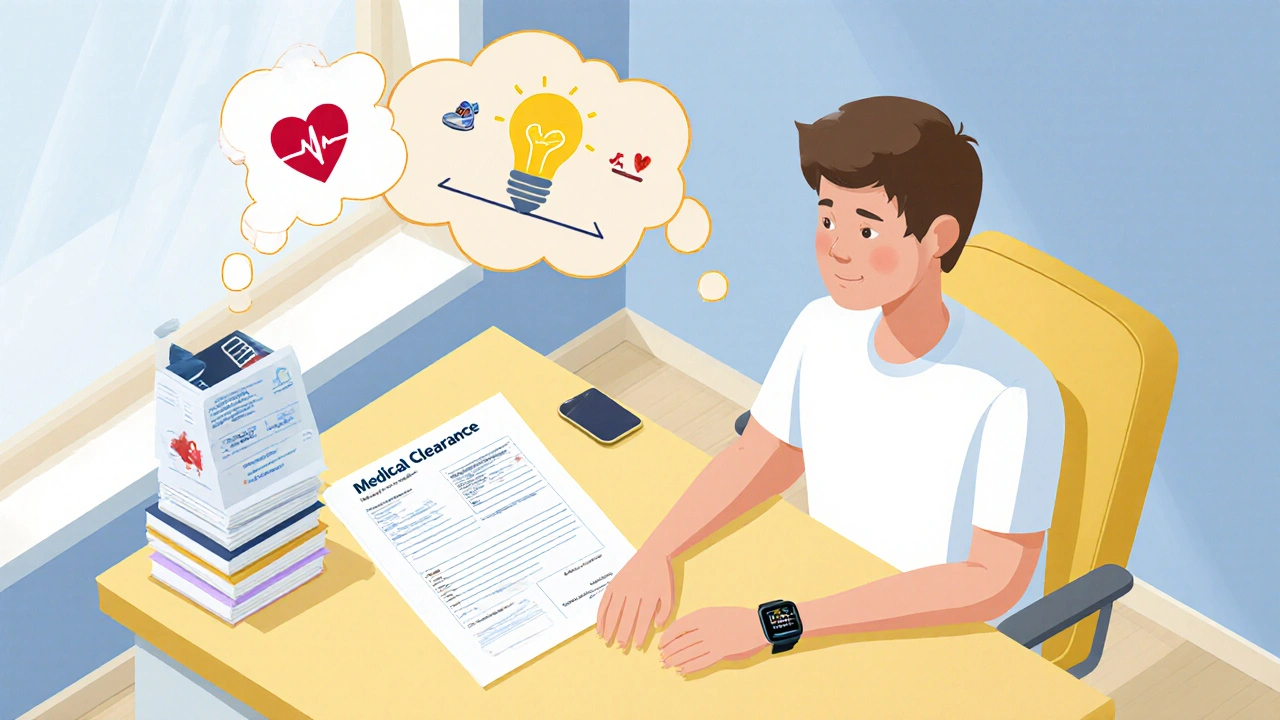Hyperthyroidism Exercise Heart Rate Calculator
Calculate Your Safe Exercise Heart Rate Zone
Based on medical guidelines for hyperthyroidism patients
Your Safe Exercise Heart Rate Zone:
Important: The article recommends staying within 50-70% of your max heart rate. Adjust intensity based on medication and symptoms.
Did you know that up to 2% of the population wrestles with hyperthyroidism, and many of them give up exercise because they fear a racing heart or constant fatigue? You don’t have to quit moving - the right plan can actually calm symptoms and boost overall health.
Quick Takeaways
- Start with a medical clearance and baseline labs (TSH, thyroid hormone levels).
- Focus on low‑to‑moderate intensity activities that keep the heart rate steady.
- Combine aerobic, strength, and flexibility work for balanced benefits.
- Stay hydrated, fuel with nutrient‑dense foods, and listen to your body’s signals.
- Adjust intensity on medication changes - don’t push through sudden energy spikes.
Understanding Hyperthyroidism
Hyperthyroidism is a condition where the thyroid gland produces too much thyroid hormone, speeding up metabolism and putting stress on the cardiovascular system. Common signs include rapid heartbeat, heat intolerance, weight loss, and tremors. When the hormone levels are unchecked, the body stays in a constant “fight‑or‑flight” mode, making sustained physical effort feel exhausting.
How Hyperthyroidism Affects Physical Activity
Excess Thyroid hormone raises the basal metabolic rate, which means you burn more calories even at rest. While that sounds beneficial, it also means you can hit fatigue faster, especially during aerobic work. The Cardiovascular system works harder, pushing the heart rate up and sometimes causing palpitations. Fatigue becomes a tricky companion - you may feel energetic one minute and utterly drained the next.
Because the heart is already beating faster, monitoring Heart rate during workouts is crucial. A simple wearable can help you stay within a safe zone (usually 50‑70% of your age‑predicted maximum) and avoid over‑exertion.

Safety First: Medical Check & Ongoing Monitoring
Before lacing up sneakers, get a clearance from your endocrinologist. Ask for the latest TSH and free Thyroid hormone numbers. If you’re on anti‑thyroid meds or beta‑blockers, note how they affect heart rate and perceived effort. Schedule follow‑up labs every 6‑12 weeks after any medication adjustment to keep the hormonal swing in check.
Choosing the Right Exercise
There’s no one‑size‑fits‑all regimen, but most people with hyperthyroidism thrive on a blend of low‑impact cardio, moderate strength work, and gentle flexibility sessions. Below is a quick guide to each category:
- Low‑impact cardio: Walking, stationary cycling, swimming, and elliptical training keep the heart rate steady without jarring joints.
- Aerobic exercise: Light jogging (if tolerated), dance‑based classes, or brisk walking for 20‑30 minutes can improve endurance.
- Strength training: Bodyweight squats, resistance‑band rows, and light dumbbell circuits maintain muscle mass, which can be lost during rapid metabolism.
- Flexibility & mind‑body: Yoga, Pilates, and tai chi help manage stress hormones and improve balance - both useful when you feel shaky.
Sample Weekly Workout Plan
Feel free to swap days based on your schedule, but aim for 4‑5 sessions a week. Adjust intensity if you notice heart‑rate spikes or excessive sweating.
| Day | Activity | Intensity (HR % Max) | Benefits | Precautions |
|---|---|---|---|---|
| Monday | 30‑minute brisk walk + 15‑minute resistance band circuit | 55‑65% | Boosts endurance, protects muscle mass | Watch for sudden tremors during band work |
| Tuesday | Yoga flow (30 min) + gentle stretching (10 min) | Low (40‑50%) | Reduces stress, improves flexibility | Avoid poses that compress the neck if you have a goiter |
| Wednesday | Stationary bike - 20 min intervals (1 min hard, 2 min easy) | 60‑70% | Cardio conditioning, calorie burn | Check heart rate; stop if it exceeds target zone |
| Thursday | Rest or light walking (15 min) | Low | Recovery, hormonal balance | Stay hydrated; avoid long sedentary periods |
| Friday | Light strength circuit - bodyweight squats, push‑ups, plank (3 sets) | 55‑65% | Preserves lean mass, supports bone health | Maintain proper form; stop if you feel dizziness |
| Saturday | Swimming or water aerobics - 30 min | 60‑70% | Low joint stress, full‑body workout | Monitor temperature; avoid overheating |
| Sunday | Active rest - garden work, casual bike ride | Low‑moderate | Keeps metabolism steady, mental refresh | Stop if you notice rapid heartbeats |
Nutrition & Lifestyle Tips to Support Exercise
Fuel matters. Since hyperthyroidism can increase appetite, focus on protein‑rich meals (lean meat, legumes, Greek yogurt) to protect muscle. Complex carbs (quinoa, sweet potatoes) provide steady energy without spikes. Include plenty of hyperthyroidism exercise friendly foods rich in calcium and vitamin D - think leafy greens, fortified plant milks, and fatty fish - because bone density can suffer when the turnover rate is high.
Stay hydrated; a fast metabolism means you lose fluids quicker. Aim for at least 2‑2.5 L of water daily, more on cardio days. Limit caffeine and stimulants - they can worsen palpitations.
If you’re on Beta‑blockers, timing meals around medication can help blunt post‑prandial spikes in heart rate.
Common Pitfalls & How to Avoid Them
- Overtraining: The temptation to burn extra calories can backfire. Stick to the target heart‑rate zones and schedule rest days.
- Ignoring medication changes: Hormone levels can swing dramatically after dose adjustments. Re‑evaluate your workout intensity within a week of any change.
- Heat exposure: Hyperthyroid patients often feel hot. Exercise in cool environments, wear breathable fabrics, and keep a water bottle handy.
- Skipping warm‑up: A 5‑minute gentle warm‑up (marching in place, shoulder rolls) primes the cardiovascular system and reduces sudden tremors.
- Neglecting sleep: Poor sleep worsens fatigue. Aim for 7‑9 hours; consider a short evening stretch routine to unwind.
Frequently Asked Questions
Can I do high‑intensity interval training (HIIT) with hyperthyroidism?
HIIT can be okay once your thyroid levels are stable, but start with very short bursts (15‑20 seconds) and watch your heart rate closely. If you experience palpitations or dizziness, switch to steady‑state cardio instead.
Is strength training safe when my metabolism is high?
Yes. Light to moderate resistance work helps preserve lean muscle that can otherwise be lost due to rapid metabolism. Keep loads moderate (5‑10 kg) and focus on good form.
Should I avoid yoga because it can raise heart rate?
Gentle yoga or restorative poses are actually beneficial. Opt for slower sequences that emphasize breathing; avoid vigorous flow classes that push the heart into a high zone.
How often should I get my thyroid labs checked while exercising?
Every 6‑12 weeks after any medication change, and at least once a year if your condition is stable. Use the results to fine‑tune workout intensity.
Can I join a group fitness class?
Absolutely, as long as the instructor knows you have hyperthyroidism and can help you stay within a safe heart‑rate zone. Choose classes that allow you to modify intensity on the fly.
Staying active with hyperthyroidism isn’t about pushing through extremes; it’s about smart, steady movement that respects your body’s hormonal rhythm. With medical guidance, a balanced workout plan, and proper nutrition, you can keep the symptoms in check and enjoy a healthier, more energetic life.
